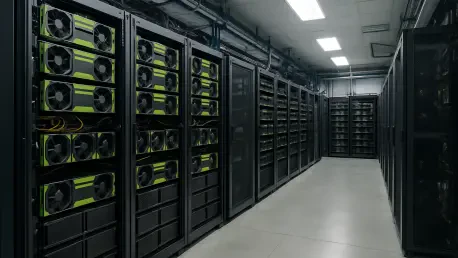In an era where artificial intelligence is reshaping industries at an unprecedented pace, the demand for cutting-edge computational power to train and deploy massive AI models has never been more critical, especially as organizations strive to handle workloads involving hundreds of trillions of parameters. Microsoft has taken a monumental step forward by integrating NVIDIA’s GB300 “Blackwell Ultra” GPUs into its Azure cloud computing platform, unveiling a first-of-its-kind large-scale production cluster designed specifically for advanced AI tasks. This development positions Azure at the forefront of technological innovation, offering unparalleled performance capabilities to researchers and businesses worldwide. By harnessing over 4,600 of these state-of-the-art GPUs across global datacenters, the platform is set to redefine the boundaries of AI training and inference, addressing both the technical and practical challenges of scaling such complex systems. This announcement signals a transformative moment in the journey toward more powerful and accessible AI solutions.
Unleashing Unmatched AI Performance
Harnessing Raw Computational Power
The scale of Azure’s new cluster is nothing short of staggering, with each rack incorporating 18 virtual machines (VMs) and 72 Blackwell Ultra GPUs paired with 36 NVIDIA Grace CPUs, delivering a jaw-dropping 1,440 petaflops of FP4 Tensor Core performance. This setup is engineered to tackle the most demanding AI workloads, ensuring that even models with vast parameter counts can be processed efficiently. Within a single rack, NVIDIA’s NVLink and NVSwitch technologies facilitate data transfer speeds of up to 130 terabytes per second, connecting 37 terabytes of fast memory to eliminate bottlenecks. Such integration significantly boosts inference throughput and cuts down latency, making it ideal for larger AI models and extended context windows. This raw power underscores a commitment to pushing the limits of what AI systems can achieve, providing a robust foundation for next-generation applications that require immense computational resources.
Scaling Seamlessly Across Datacenters
Beyond individual racks, Azure employs a non-blocking, full fat-tree architecture with NVIDIA Quantum-X800 InfiniBand, offering 800 gigabits per second of cross-rack bandwidth per GPU to ensure seamless scalability. This design allows the system to expand to tens of thousands of GPUs with minimal communication overhead, optimizing end-to-end training throughput and GPU utilization. The result is a drastic reduction in costs for compute-intensive AI workloads, as resources are used more efficiently across global datacenters. This scalability is crucial for organizations looking to deploy AI solutions on a massive scale, as it ensures consistent performance even as demands grow. By minimizing inefficiencies in data transfer and resource allocation, Azure provides a platform that can adapt to the evolving needs of AI developers, making it a cornerstone for innovation in the field.
Optimizing Infrastructure for AI Innovation
Accelerating Model Training and Deployment
One of the most transformative aspects of this integration is the dramatic reduction in training times for AI models, with Azure’s Blackwell Ultra-powered cluster capable of shrinking timelines from months to mere weeks. This acceleration unlocks the potential to develop models of unprecedented complexity, tailored for advanced workloads like reasoning models, agentic AI systems, and multimodal generative AI applications. NVIDIA’s established dominance in inference performance, validated by benchmarks such as MLPerf and InferenceMAX AI tests, further ensures that real-time AI tasks are handled with exceptional efficiency. This capability empowers developers to iterate faster, test more sophisticated algorithms, and bring cutting-edge solutions to market at an accelerated pace. The impact on industries relying on AI—from healthcare to finance—could be profound, as quicker development cycles translate to faster innovation and deployment.
Engineering Efficiency and Sustainability
Supporting such high-performance computing requires meticulous infrastructure optimization, and Azure rises to the challenge with a co-engineered software stack that includes custom protocols and collective libraries to maximize network reliability. Features like NVIDIA SHARP enhance collective operations by performing computations within the switch, effectively doubling bandwidth for large-scale training and inference tasks. Additionally, the thermal and energy demands of dense GPU clusters are addressed through advanced cooling systems using standalone heat exchangers and facility cooling to maintain stability while minimizing water usage. New power distribution models have also been developed to manage high energy density and dynamic load balancing for the ND GB300 v6 VM class. These efforts reflect a balanced approach to performance and sustainability, ensuring that the environmental footprint of such powerful systems remains manageable while maintaining operational excellence.
Paving the Way for AI Leadership
Reflecting on this milestone, the collaboration between Microsoft and NVIDIA through Azure’s integration of GB300 Blackwell Ultra GPUs marks a defining moment in the global AI landscape. The deployment of these advanced VMs to customers signals a shift toward democratizing access to high-performance computing, enabling a broader range of researchers and businesses to tackle complex challenges with greater speed. This partnership not only showcases technological prowess but also highlights a strategic push to maintain leadership in AI innovation. Looking ahead, the focus should remain on expanding access to such resources, refining infrastructure for even greater efficiency, and exploring new applications for these powerful tools. As the industry continues to evolve, stakeholders must prioritize sustainable practices and collaborative efforts to ensure that the benefits of these advancements reach diverse sectors, driving progress on a global scale.









